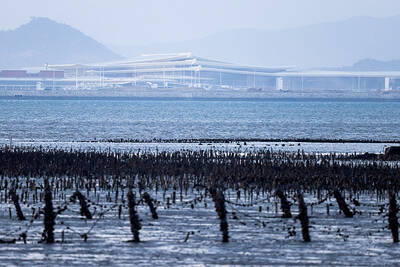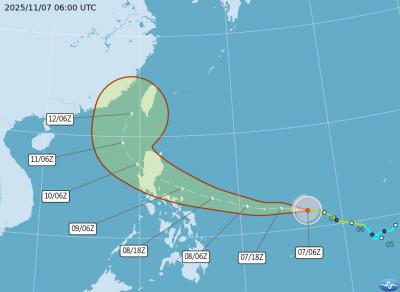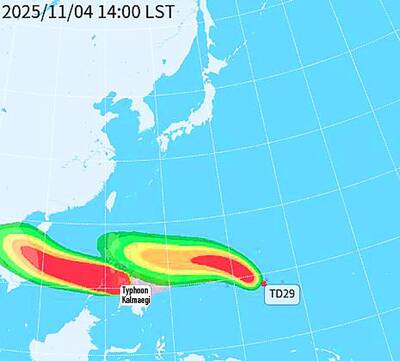One of the two parts of a treasured Chinese brush painting is on its way from Zhejiang Province, China, to Taiwan, where it will be reunited with the rest of the painting for an exhibition at the National Palace Museum.
The painting, titled Dwelling in the Fu Chun Mountains (富春山居圖), was created by Yuan Dynasty artist Huang Gong-wang (黃公望). Just over 300 years later, in 1651, the painting was almost destroyed. The then-owner loved it so much it he attempted to burn it so he would it have in the afterworld when he died. A nephew was able to rescue the painting, but it had already come apart.
The first half, retitled The Broken Mountains, stayed in private hands until after World War II, when it ended up at the Zhejiang Provincial Museum.
The longer section had several owners before becoming part of the imperial collection under the Qianlong emperor and after the 1911 revolution it became part of the collection at the Palace Museum in the Forbidden City.
The longer section ended up in Taiwan, with many of the Palace Museum treasures, when the Chinese Civil War ended in 1949.
The painting drew attention in both China and Taiwan when Chinese Premier Wen Jiabao (溫家寶) said last year he hoped the painting could be “reunited,” implying his desire for the unification of Taiwan and China.
The painting will be on display from June 1 through Sept. 5.
After the Taipei exhibition, there will not be a reciprocal exchange with Zhejiang.
The National Palace Museum fears any national treasures it might send for exhibition in China could be seized by the authorities and it has said it will not lend anything unless it receives a guarantee from the Chinese government that it will be returned.
China claims ownership of all of the Palace Museum pieces that were brought to Taiwan by the Chinese Nationalist Party (KMT) at the end of the war.

Three Taiwanese airlines have prohibited passengers from packing Bluetooth earbuds and their charger cases in checked luggage. EVA Air and Uni Air said that Bluetooth earbuds and charger cases are categorized as portable electronic devices, which should be switched off if they are placed in checked luggage based on international aviation safety regulations. They must not be in standby or sleep mode. However, as charging would continue when earbuds are placed in the charger cases, which would contravene international aviation regulations, their cases must be carried as hand luggage, they said. Tigerair Taiwan said that earbud charger cases are equipped

UNILATERAL MOVES: Officials have raised concerns that Beijing could try to exert economic control over Kinmen in a key development plan next year The Civil Aviation Administration (CAA) yesterday said that China has so far failed to provide any information about a new airport expected to open next year that is less than 10km from a Taiwanese airport, raising flight safety concerns. Xiamen Xiangan International Airport is only about 3km at its closest point from the islands in Kinmen County — the scene of on-off fighting during the Cold War — and construction work can be seen and heard clearly from the Taiwan side. In a written statement sent to Reuters, the CAA said that airports close to each other need detailed advanced

Tropical Storm Fung-Wong would likely strengthen into a typhoon later today as it continues moving westward across the Pacific before heading in Taiwan’s direction next week, the Central Weather Administration (CWA) said. As of 8am, Fung-Wong was about 2,190km east-southeast of Cape Oluanpi (鵝鑾鼻), Taiwan’s southernmost point, moving westward at 25kph and possibly accelerating to 31kph, CWA data showed. The tropical storm is currently over waters east of the Philippines and still far from Taiwan, CWA forecaster Tseng Chao-cheng (曾昭誠) said, adding that it could likely strengthen into a typhoon later in the day. It is forecast to reach the South China Sea

WEATHER Typhoon forming: CWA A tropical depression is expected to form into a typhoon as early as today, the Central Weather Administration (CWA) said yesterday, adding that the storm’s path remains uncertain. Before the weekend, it would move toward the Philippines, the agency said. Some time around Monday next week, it might reach a turning point, either veering north toward waters east of Taiwan or continuing westward across the Philippines, the CWA said. Meanwhile, the eye of Typhoon Kalmaegi was 1,310km south-southeast of Oluanpi (鵝鑾鼻), Taiwan’s southernmost point, as of 2am yesterday, it said. The storm is forecast to move through central